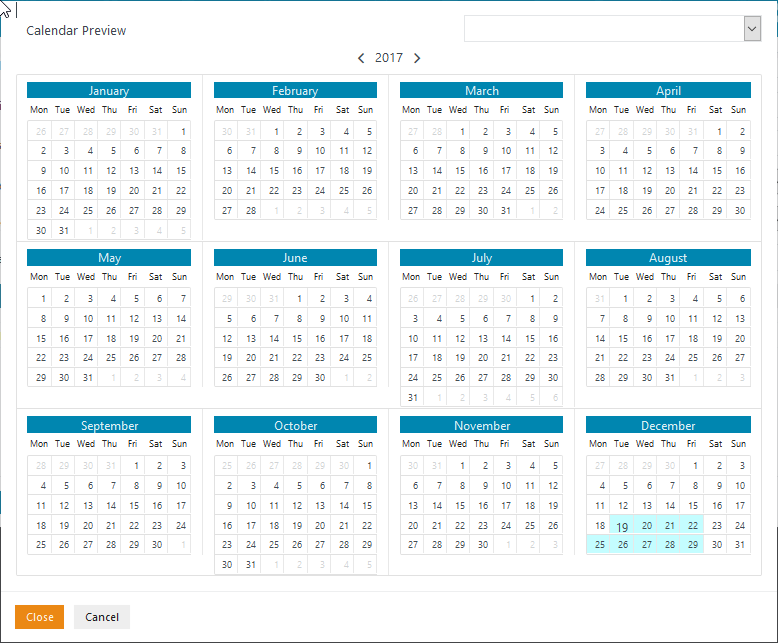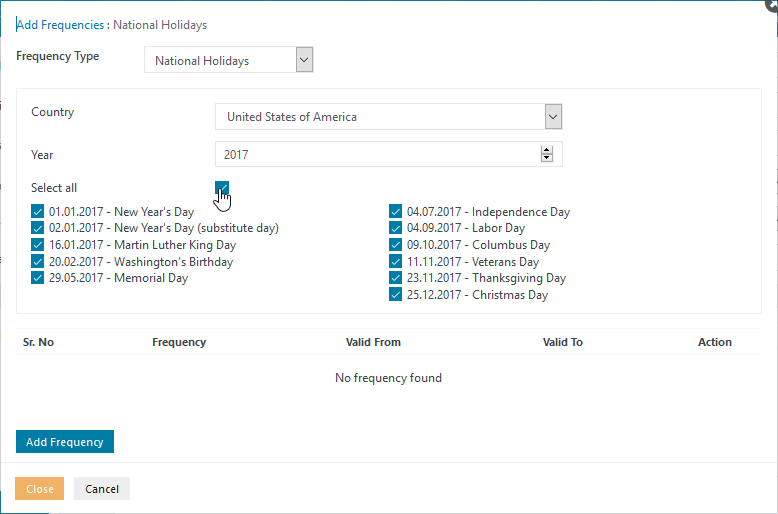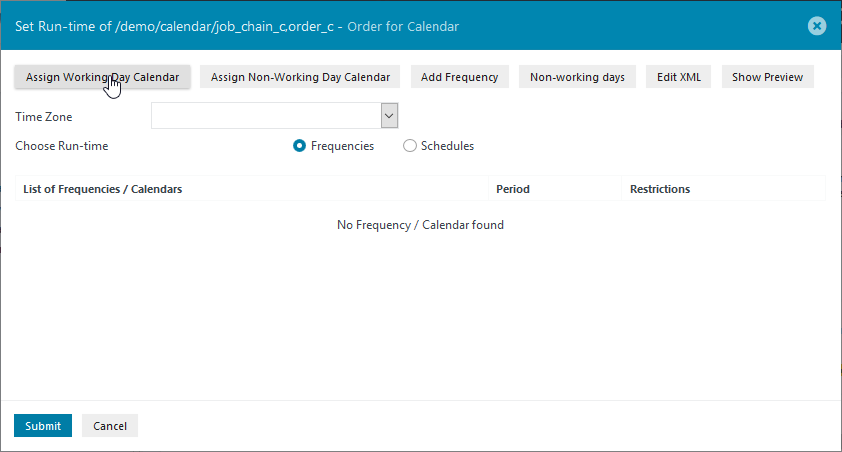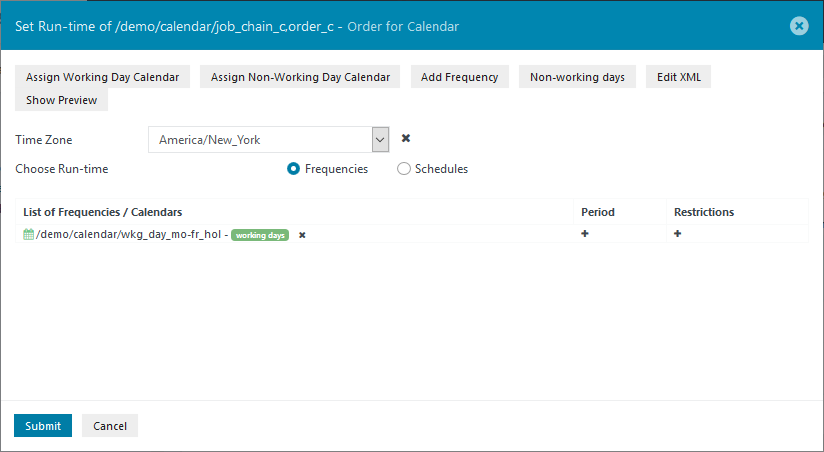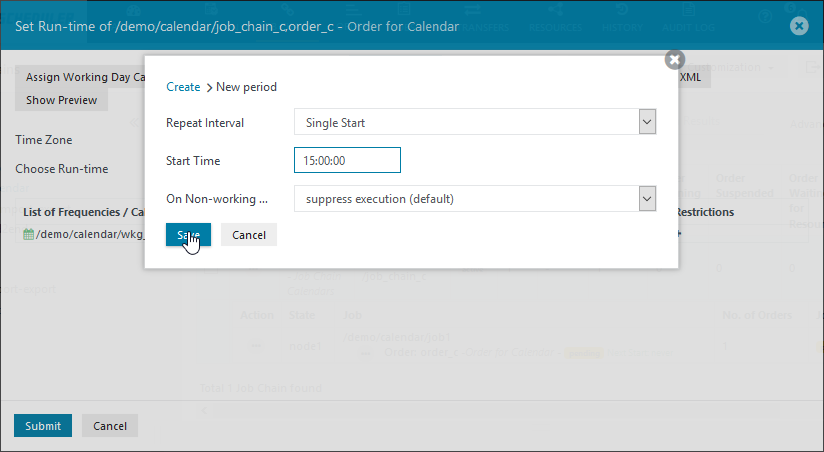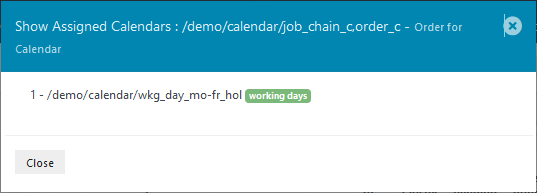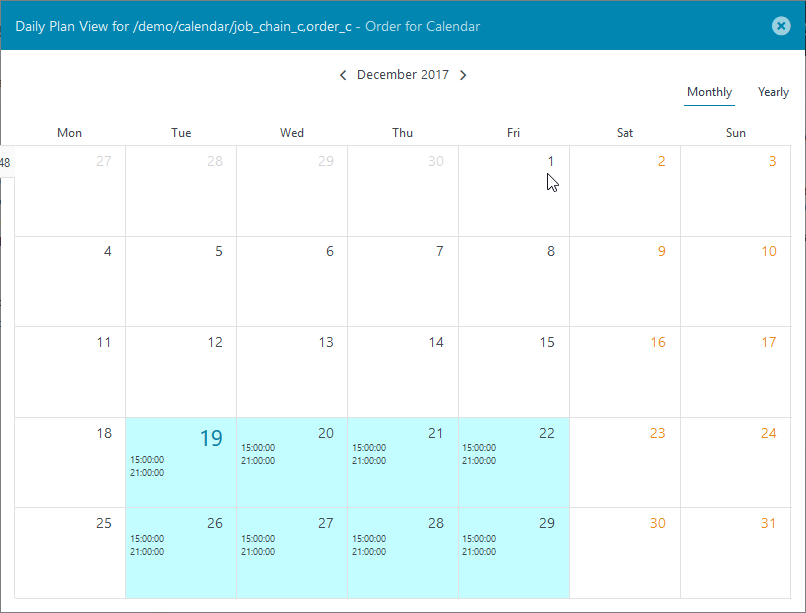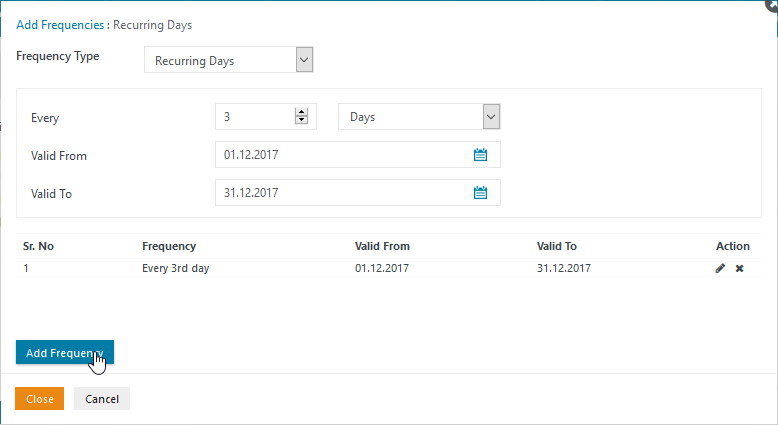Introduction
JobScheduler Calendars can be configured to meet a wide range of business requirements. This article first describes how to configure a basic five-day working day Calendar and then modify the Calendar so that an Order is only executed every third business day.
Article Scope
This article describes how to configure basic Calendars with the intention that users will be able to adapt the procedures described to meet a large part of their everyday needs. This article is not intended to provide a description of all the possible configuration items. An overview of the JOC Cockpit's Calendar feature is provided in the JOC Cockpit - Calendar Management article.
Configuration Steps
Create Calendar
Calendars are created in the JOC Cockpit Resources / Calendars view by clicking the Add Calendar button as shown in the first screenshot.
Note that the creation of Calendars requires that a user is signed in with an account that has been granted the necessary permissions. See your system administartor if you are not able to follow the examples shown.
This will open the Create Calendar modal window. To create a simple Calendar that should be filled out as shown in the next screenshot:
Note that additional fields (Option for Reason, Select Reason, etc.) may be shown at the start of the Create Calendar window. The information for these fields is for the Audit Log and settings in the user's account determine whether or not these fields are shown and are mandatory. See the Reasons setting section of the Audit Log article for more information.
The Name, Type, and End Date fields are mandatory: the Category, Path and Valid From fields are not.
The Path field allows to store the Ćalendar in a folder structure. Use a slash "/" to separate sub-folders.
If a Valid From date is not set then the current date will be used.
Configure a Monday to Friday Working Week
The working days are configured by specifying a number of Frequencies for the Calendar. Frequencies are rule sets for weekdays, month days, recurring days etc.
The Add Frequency button will become active once the information described in the previous section has been entered. Leave the Included Frequencies tab active.
Click on the Add Frequencies button and in the the Weekdays Tab, which is the default tab, fill out the Weekdays section as shown in the next screenshot.
Clicking on the Add Frequency button as shown above will cause the days selected to be noted as shown in the next screenshot.
Note that no configuration information has not yet been saved.
View the configured Frequency
Click on the Calendar icon under the Action header. This will open a preview of the Calendar.
Now click on the Close button to close the preview and then click on Close in the Add Frequencies modal to return to the Create Calendar window which will display the list of Included Frequencies as shown.
Exclude National Holidays from the List of Working Days
Now click on the Excluded Frequencies tab to add days for which no jobs should be executed and then on the Add Frequency button.
In the Add Frequencies window now select the National Holidays tab and then a country - here the USA. This will cause a list of national holidays to be displayed. Select All and then enter the current year (in this case 2017) in the Year field. Click on Add Frequency. This will result in the following screenshot:
As our Included Frequencies were up to 2018, holidays should also be added for that year.
The list of excluded working days will now appear as shown in the above screenshot.
Clicking once again in the Calendar icon below the Action header will reopen the Calendar Preview window.
Selecting the All Frequencies in the Select box at the top right of the window and the year 2018 will show the following:
Note that days selected in the Non-Working Days tab are marked as active (orange background) and that days that were unspecified (Saturday and Sunday) are left white.
Now click on the Close button to return to the Add Frequencies window and then Close again to return to the Create Calendar window.
Then use the Submit button to save the configuration and return to the Resources / Calendar view as shown in the next screenshot.
This Calendar is now ready to be used for an Order or Job.
Assigning the Calendar to an Order
Go to the Job Chains view and select an Order. The Job Chain and Order to be used for this article are shown in the screenshot below.
Open the Set Run-time modal window for the Order as shown.
Use the Assign Working Days Calendar button to open the Calendar selection window.
Select the calendar and then click on the Apply button - not shown in the screenshot - to return to the Set Run-time modal window which will now appear as shown below:
The next screenshot shows how the Edit XML button in the Set Run-time window can be used to inspect and edit individual entries in the Calendar configuration:
Configuring the Periods (Run-Times) for the Order
Periods are used to specify the time or times at which a Job or Order will run on the days that have been specified in the Calendar. Configuration of a new Period is started by clicking on the + symbol alongside the relevant calendar as shown in the screenshot above. This will open the Create Period modal window.
Clicking the Save button now will cause the Period configuration to be added to the Order. The next screenshot shows that two Single Start Periods have been configured - at 15:00 and at 21:00.
Note that the changes made to the configuration will only be saved when the Submit button is clicked.
Clicking the Submit button will close the Set Run-time modal window and return to the Job Chains view.
A short time after this is carried out the Next Start time for the Order should change from 00:00:00 to the correct value - in this case 24.11.2017 21:00 as shown in the screenshot below.
Inspecting the Configuration
The Show Assigned Calendars menu (ellipsis symbol shown in the previous screenshot) can be used to show which calendar(s) has or have been Assigned to an Order as shown in the next screenshot:
The Show Calendar item in the same menu can be used to show either Monthly or Yearly views of the calendars.
Individual Period starts are shown in the Monthly views (first screenshot below) and unspecified and excluded days are highlighted in the Yearly view (second screenshot below).
Restricting Job Starts
The situation where Jobs and Orders are not to run on every working day can also be readily incorporated in Calendars.
This section of the article describes how to extend the configuration so that the Order only runs on every 3rd working day, taking account of holidays and weekends.
Procedure
Re-open the Wkg Day - Mo-Fr Calender using the Edit Calendar menu item as shown below.
Select the Edit Frequency function (pencil icon) in the Update Calendar window as shown:
Now, in the Update Frequencies window select the Recurring Days tab and complete the fields as shown:
Click Add Frequency and the Frequency entry will be modified as shown in the screenshot above.
Now click on Close to return to the Set Run-time window.
The final configuration, if required, is to edit the Periods and specify the behavior On Holiday.
The default Suppress Execution setting can be seen in the following screenshot
Calculation starts with the 1st of January, which, with the 15th is a non-working day in the USA. Here the wrong values are calculated ....




